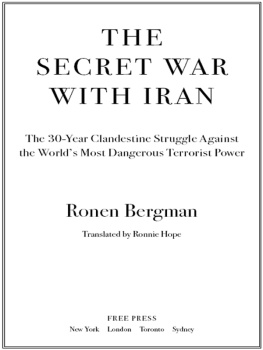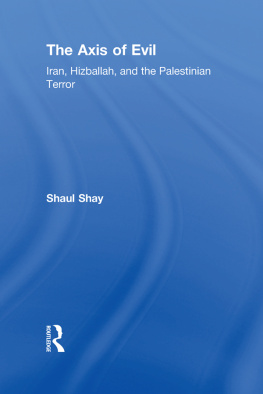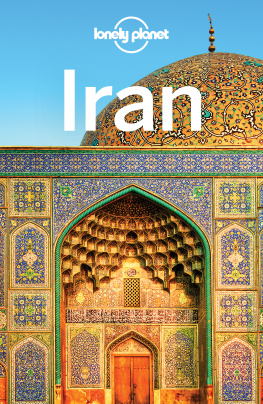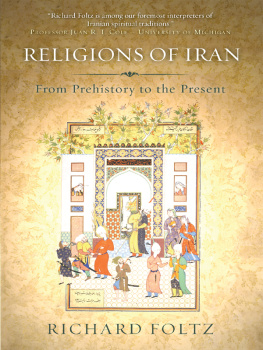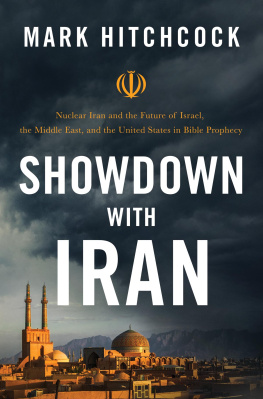

FREE PRESS
A Division of Simon & Schuster, Inc.
1230 Avenue of the Americas
New York, NY 10020
Nekudat Haal Chazor copyright 2007 by Ronen Bergman
Translation copyright 2008 by Simon & Schuster, Inc.
Originally published in Israel as Nekudat Haal Chazor in 2007 by Kinneret, Zmora-Bitan, DvirPublishing House Ltd, Or Yehuda, Israel
All rights reserved, including the right to reproduce this book or portions thereof in any form whatsoever. For information address Free Press Subsidiary Rights Department, 1230 Avenue of the Americas, New York, NY 10020
FREE PRESS and colophon are trademarks of Simon & Schuster, Inc.
Library of Congress Cataloging-in-Publication Data
Bergman, Ronen.
The secret war with Iran: the 30-year clandestine struggle against the worlds most dangerous terrorist power / Ronen Bergman.
p. cm.
1. IranForeign relations20th century. 2. IranForeign relations21st century. 3. IranMilitary relations. I. Title.
DS274.B47 2008
955.05'4dc22
2008013640
ISBN-13: 978-1-4165-6490-4
ISBN-10: 1-4165-6490-X
Visit us on the World Wide Web:
http://www.SimonSays.com
For my father,
Shmuel Bergman:
He sets the standards
for kindness, honesty, and devotion.
CONTENTS
PART I
GREEN STORM RISING
PART II
THE HIDDEN WAR IN THE MIDDLE EAST
PART III
THE GLOBAL WAR
PART IV
THE SECOND COMING OF HIZBALLAH
PART V
THE FIRST SHIITE BOMB
PREFACE
George W. Bush famously described Iran as part of the axis of evil, while Iranian leaders regularly refer to the United States as the Great Satan. But presidential rhetoric in Washington and Tehran aside, the Iranian clerical regime (and not the Iranian People) is unquestionably an enemy of the United States. Consider: Iran has chemical weapons and an active nuclear weapons program. It is a sponsor of international terrorism. It is dedicated to spreading a brand of Islamic revolution that is virulently anti-Western. In short, many of the concerns that were citedand disputedas grounds for invading Iraq are indisputably true of Iran.
True, Iran has not launched full-scale invasions against its neighbors, as Saddam Hussein did against both Iran and Kuwait. Instead, it has been skillful in conducting its military adventures so as to avoid the wrath of the West. For the past twenty years Iran has masterfully used Hizballah as a proxy, maintaining a veneer of deniability. It has sponsored terrorists, working closely with al-Qaeda prior to 9/11, after which point it became expedient to maintain some distance from that network. And while the world had become obsessed with Osama bin Laden and his lieutenants, it forgot that the most dangerous of all terrorists before the advent of al-Qaeda, a Lebanese Shiite by the name of Imad Moughniyeh, who was responsible for the death and kidnapping of the biggest number of Americans until 9/11, was alive and well and a frequent welcome visitor to Tehran, until he was blown up by a car bomb in Damascus early in 2008.
The Iranian threat is a top priority of the U.S. defense and foreign policy establishment. This threat has appeared particularly urgent ever since Western intelligence agenciesthe CIA and the Mossad, as well as MI6, the French DGSE, and the German intelligence servicesuddenly realized in 2002 that despite their concerted and often coordinated efforts to track the development of Irans nuclear program, and their overall assessment that Irans nuclear ambitions were being successfully contained, the Iranians had been able to fool them. Their nuclear program has advanced to the point where production of an Iranian nuclear bomb is now probably no more than a few years away.
This unsettling discovery raises a fundamental question: What exactly are Irans nuclear ambitions? When the day dawnsas it may well soon doand Iran is in possession of a nuclear bomb, what will it use it for? According to a CNN/USA Today/Gallup Poll from 2006, over 80 percent of Americans believe that Iran would supply nuclear weapons to terrorists to be used against the United States. Many in the U.S. defense establishment agree. Indeed, the Pentagon and the CIA, in close cooperation with Israels Mossad and the Israeli air force, are drawing up plans to deliver a knockout blow to Irans nuclear installations before any weapons are produced. However, it is also possiblesome would say probablethat the main purpose for which Iran wants nuclear weapons is to deter the United States from doing to Iran what it has done to Saddam Hussein.
What is clear today is that any decision to strike Iran from a distancemuch less invade itcan only be made against the background of the bitter experience in Iraq. America went to war against one man, Saddam, and defeated him, only to become mired in the quicksand of the complex and intractable tribal and religious conflicts of an entire country. If there is one thing that everyone agrees on, it is that drawing lessons from the military imbroglio in Iraq is imperative. And the most important of these lessons is that there is no substitute for high-quality intelligence. Know thy enemy, both his strengths and his weaknesses. Even if the startling and disputed announcement in the U.S. National Intelligence Estimates in 2007 that Iran had halted its nuclear weapons project in 2003 was correct, it is clear to all that Iran could easily pick up where it left off, using the enriched uranium that it admits it is producing.
The problem is that after three decades of trying to meet the Iranian challenge with a variety of strategiescovert negotiations, arms deals, critical dialogue, containment, direct political confrontation, and indirect action against its proxieswe still do not understand Iran. We do not know what its leaders want to do, and we do not know how to stop them from doing it.
Or, at least, we do not know enough. The West, most notably the United States and Israel, has maintained for three decades an effort to gather, analyze, share, and act upon covert intelligence on Iran. This book follows the drama of this secret intelligence struggle against Iran. At its heart are the two most concerned countries: Israel and the United States. Both have played a complex role, each trying to compensate for the others disadvantages, as they cooperate in intelligence gathering and in operations. There have been many failures, and some successes, too. This book brings these fascinating and sobering stories to light, in order to contribute to the understanding of a regime that is a far greater danger to the West than Saddam Husseins Iraq ever was.
The story ventures along the secret paths inside the intelligence communities of both countries, while describing in detail many Mossad operations. The United States relies on Israels intelligence agencies for much of its Middle Eastern intelligence collection. Israeli successes are immediately shared with the United States and Israeli failure means American blindness. In many instances, Israel and its battles have served as testing grounds for American weapons and for combat tactics developed in the United States.
This book is based on thousands of documents, and some three hundred interviews with pertinent people in twenty countries, the names of two hundred of whom appear in the Bibliography. Unless cited specifically in the text, all interviews quoted were conducted by the author. A detailed survey of Irans part in international terror requires the use of intelligence material gathered by Israel, the United States, France, the United Kingdom, and Germany. Research on such a subject is highly complex. Many sources are necessarily anonymous. Disinformation and simple errors have often crept into journalists reports on Iran. I have made every attempt to verify and cross-check the information here, yet it is not always possible to be certain of every detail; intelligence sources have their own agendas. Whenever accounts differ, I have tried to say so.

